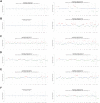The Presence of Genomic Instability in Cerebrospinal Fluid in Patients with Meningeal Metastasis
- PMID: 34188538
- PMCID: PMC8232886
- DOI: 10.2147/CMAR.S295368
The Presence of Genomic Instability in Cerebrospinal Fluid in Patients with Meningeal Metastasis
Abstract
Purpose: This study aimed to explore the genomic instability in cerebrospinal fluid (CSF) in patients with meningeal metastasis (MM).
Material and methods: We collected the blood and CSF samples of 15 MM patients and one brain parenchymal metastasis (BPM) patient. A panel of 543 cancer-related genes was conducted to analyze the status of genomic instability in CSF and plasma cell-free DNA (cfDNA) of all patients. Subsequently, nine patients underwent low-depth whole-genome sequencing (WGS) analysis to verify the existence of genomic instability, followed by genomic scoring by the application of aneuploidy scores. Diagnosis-specific graded prognostic assessment (DS-GPA) score was utilized to assess the clinical status of MM patients.
Results: There was significant difference in gene mutation between CSF cfDNA and plasma cfDNA in MM patients. Among them, 12 MM patients developed genomic instability in their CSF cfDNA, while the remaining 3 had stable genetic profile. Besides, BPM patients showed genomic stability in his CSF and paraffin-embedded tissue sections. No genomic instability was noticed in plasma cfDNA of all patients. Sensitive mutations on EGFR, ERBB2, ALK and KRAS genes and increased gene copy numbers of MET and ERBB2 were detected in 10 MM patients with genomic instability, as well as the EGFR gene mutation in one MM case with genomic stability. Additionally, MM patients with genomic instability had lower overall survival and higher aneuploidy scores and tumor mutation burden compared with those with genomic stability. Moreover, MM patients with higher DS-GPA scores benefited from better survival.
Conclusion: Genomic instability existed in the CSF cfDNA rather than plasma cfDNA of MM patients, which might be the underlying cause of the differences in MM.
Keywords: cell-free DNA; cerebrospinal fluid; genomic instability; meningeal metastasis; panel; whole-genome sequencing.
© 2021 Wang et al.
Conflict of interest statement
The authors declare that they have no competing interests.
Figures





Similar articles
-
Genomic Instability in Cerebrospinal Fluid Cell-Free DNA Predicts Poor Prognosis in Solid Tumor Patients with Meningeal Metastasis.Cancers (Basel). 2022 Oct 14;14(20):5028. doi: 10.3390/cancers14205028. Cancers (Basel). 2022. PMID: 36291812 Free PMC article.
-
Cerebrospinal Fluid Cell-Free DNA-Based Detection of High Level of Genomic Instability Is Associated With Poor Prognosis in NSCLC Patients With Leptomeningeal Metastases.Front Oncol. 2022 Apr 28;12:664420. doi: 10.3389/fonc.2022.664420. eCollection 2022. Front Oncol. 2022. PMID: 35574310 Free PMC article.
-
Unique genetic profiles from cerebrospinal fluid cell-free DNA in leptomeningeal metastases of EGFR-mutant non-small-cell lung cancer: a new medium of liquid biopsy.Ann Oncol. 2018 Apr 1;29(4):945-952. doi: 10.1093/annonc/mdy009. Ann Oncol. 2018. PMID: 29346604
-
Using circulating cell-free DNA to monitor personalized cancer therapy.Crit Rev Clin Lab Sci. 2017 May;54(3):205-218. doi: 10.1080/10408363.2017.1299683. Epub 2017 Apr 10. Crit Rev Clin Lab Sci. 2017. PMID: 28393575 Review.
-
Beyond the Blood: CSF-Derived cfDNA for Diagnosis and Characterization of CNS Tumors.Front Cell Dev Biol. 2020 Feb 18;8:45. doi: 10.3389/fcell.2020.00045. eCollection 2020. Front Cell Dev Biol. 2020. PMID: 32133357 Free PMC article. Review.
Cited by
-
Genomic Instability in Cerebrospinal Fluid Cell-Free DNA Predicts Poor Prognosis in Solid Tumor Patients with Meningeal Metastasis.Cancers (Basel). 2022 Oct 14;14(20):5028. doi: 10.3390/cancers14205028. Cancers (Basel). 2022. PMID: 36291812 Free PMC article.
References
-
- Cui JZ, He JY, Li Q, et al. Advancements in diagnosis and treatment of meningeal carcinomatosis in solid cancer. Neurol Neuroimmunol Neuroinflamm. 2017;4(9):167. doi:10.20517/2347-8659.2017.26 - DOI
LinkOut - more resources
Full Text Sources
Research Materials
Miscellaneous

